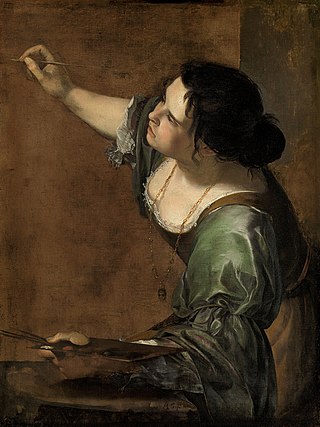
Artemisia Lomi or Artemisia Gentileschi was an Italian Baroque painter. Gentileschi is considered among the most accomplished seventeenth-century artists, initially working in the style of Caravaggio. She was producing professional work by the age of 15. In an era when women had few opportunities to pursue artistic training or work as professional artists, Gentileschi was the first woman to become a member of the Accademia di Arte del Disegno in Florence and she had an international clientele.

Venus and Cupid (Sleeping Venus) is a circa 1626 painting by Artemisia Gentileschi in the Virginia Museum of Fine Arts. Venus and Cupid is a depiction of a sleeping Venus, who reclines on a blue bed covering and rich crimson and gold tasseled pillow. She wears nothing except a thin wisp of transparent linen around her thigh. Her son Cupid fans her with richly colored peacock feathers as she drifts to sleep. He is gazing at her with an adored, raptured expression. In the background, there is a window looking out onto a moonlight landscape where a temple to the goddess lies. Venus's face has full cheeks, heavy lids, a prominent nose, and small protruding chin—all features of Gentileschi's own face. The body movements are natural: Venus's hand rests lightly on her side, her legs are gently laid together. The work blends together realism and classicism through its iconography and the artist's style.
This is an ongoing bibliography of work related to the Italian baroque painter Artemisia Gentileschi.
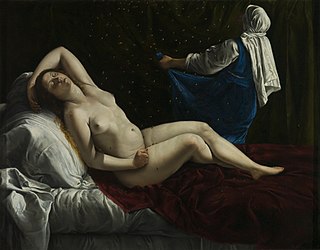
Danaë is a 1612 painting by the Italian Baroque artist Artemisia Gentileschi. It hangs in the Saint Louis Art Museum, United States.
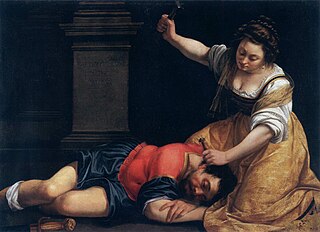
Jael and Sisera is a painting by the Italian Baroque artist Artemisia Gentileschi, executed around 1620.

Santa Cecilia is an early painting, from c. 1620, by the Baroque painter Artemisia Gentileschi, a painter described as "a grand exception in the history of art - a successful woman painter in an era in which art was dominated by men."
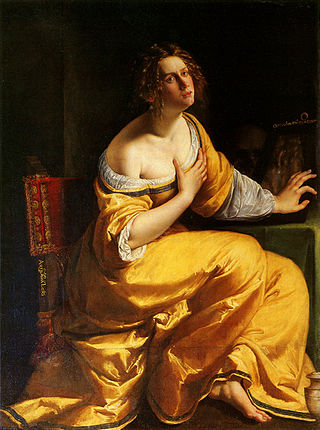
Penitent Magdalene is a 1616–1618 painting by the Italian baroque artist Artemisia Gentileschi. This painting hangs in the Pitti Palace in Florence. The subject is the biblical figure Mary Magdalene, but the painting references another biblical woman, Mary, the sister of Lazarus. This painting was likely painted during Gentileschi's Florentine period.
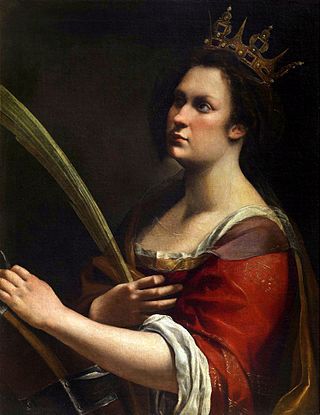
Saint Catherine of Alexandra is a painting by the Italian Baroque artist Artemisia Gentileschi. It is in the collection of the Uffizi, Florence. Gentileschi likely used the same cartoon or preparatory drawing to create both this painting and the Self-Portrait as Saint Catherine of Alexandria (1615–1617), now in the National Gallery, London.

The Allegory of Painting is an painting from around the 1640s attributed in 1988 to the Italian Baroque artist Artemisia Gentileschi, although more recent research suggests it was painted by an anonymous Neapolitan painter in the mid-XVIIth century. It is now in the Musee de Tesse, Le Mans, France.

The Portrait of a Gonfaloniere is a painting by the Italian baroque artist Artemisia Gentileschi. It hangs in the Palazzo d'Accursio, Bologna. It is a portrait of an unknown gonfaloniere standing in full regalia and was painted in 1622. Mary D. Garrard has speculated that the man may be Pietro Gentile of Genoa.

Susanna and the Elders is one of several paintings on this theme executed by the Italian baroque artist Artemisia Gentileschi. This version, painted in 1649, hangs in the Moravian Gallery in Brno, Czech Republic. It is signed with Gentileschi's signature and the date on the balustrade on the right.

Lucretia is a painting by the Italian baroque artist Artemisia Gentileschi. It depicts Lucretia, the wife of Roman consul and general Tarquinus, at the moment of her suicide. The decision to take her own life was made after she was blackmailed and raped by a fellow soldier of Tarquinus. It is one of a number of paintings of Gentileschi that focus on virtuous women ill-treated by men.

The Self Portrait of Italian baroque artist Artemisia Gentileschi was painted in the early 1630s. It currently hangs in the Palazzo Barberini, Rome. It is one of many paintings where Gentileschi depicts herself. Beyond self-portraits, her allegorical and religious paintings often featured herself in different guises.

The Birth of Saint John the Baptist, by Artemisia Gentileschi, was part of a six-painting portrayal of Saint John's life, with four of the paintings by Massimo Stanzione and one by Paolo Finoglia, for the Hermitage of San Juan Bautista on the grounds of Buen Rierto in Madrid, under orders from the Viceroy of Naples, the Conde de Monterrey. Although a date has not been agreed upon by scholars, Artemesia most likely painted The Birth of Saint John the Baptist between 1633 and 1635. It is one of the most renowned works from Artemisia's Naples period, especially due to its detailed rendering of fabrics and floor tiles.
Allegory of Inclination is a 1615-1617 oil on canvas painting by Artemisia Gentileschi on the ceiling of the Galleria in the Casa Buonarroti, in Florence. The painting depicts a young nude female seated in the heavens holding a compass. Her light-colored hair is elaborately styled and she is partially covered by swirling drapery. A star appears above her head.

Saint Januarius in the Amphitheatre at Pozzuoli is a 1635-1637 oil on canvas painting by Artemisia Gentileschi. The work shows the moment that the Christian martyr Januarius and his followers are thrown to a group of wild animals in the amphitheatre in Pozzuoli - however, they lick the saint's feet rather than attacking him and Januarius is unharmed.

Cleopatra is a 1611-1612 oil on canvas painting of Cleopatra by Artemisia Gentileschi, now in the private Etro collection in Milan.

Bathsheba is a 1636-37 painting by the Baroque painter Artemisia Gentileschi, with contributions by Viviano Codazzi and Domenico Gargiulo. It shows the Hittite woman Bathsheba being washed and tended to by her servants. At the top left of the painting, King David sees her from his palace. It was one of seven versions from the story of Bathsheba that Gentileschi painted.
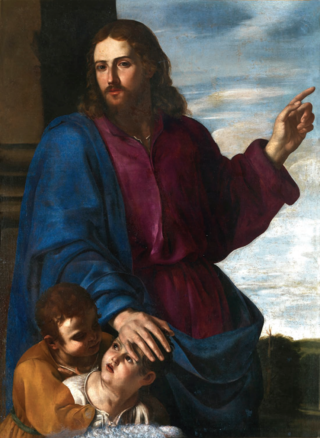
Christ Blessing the Children is a painting by the Italian artist Artemisia Gentileschi, depicting an episode from the New Testament. It hangs in the church of S. Carlo al Corso in Rome.

















